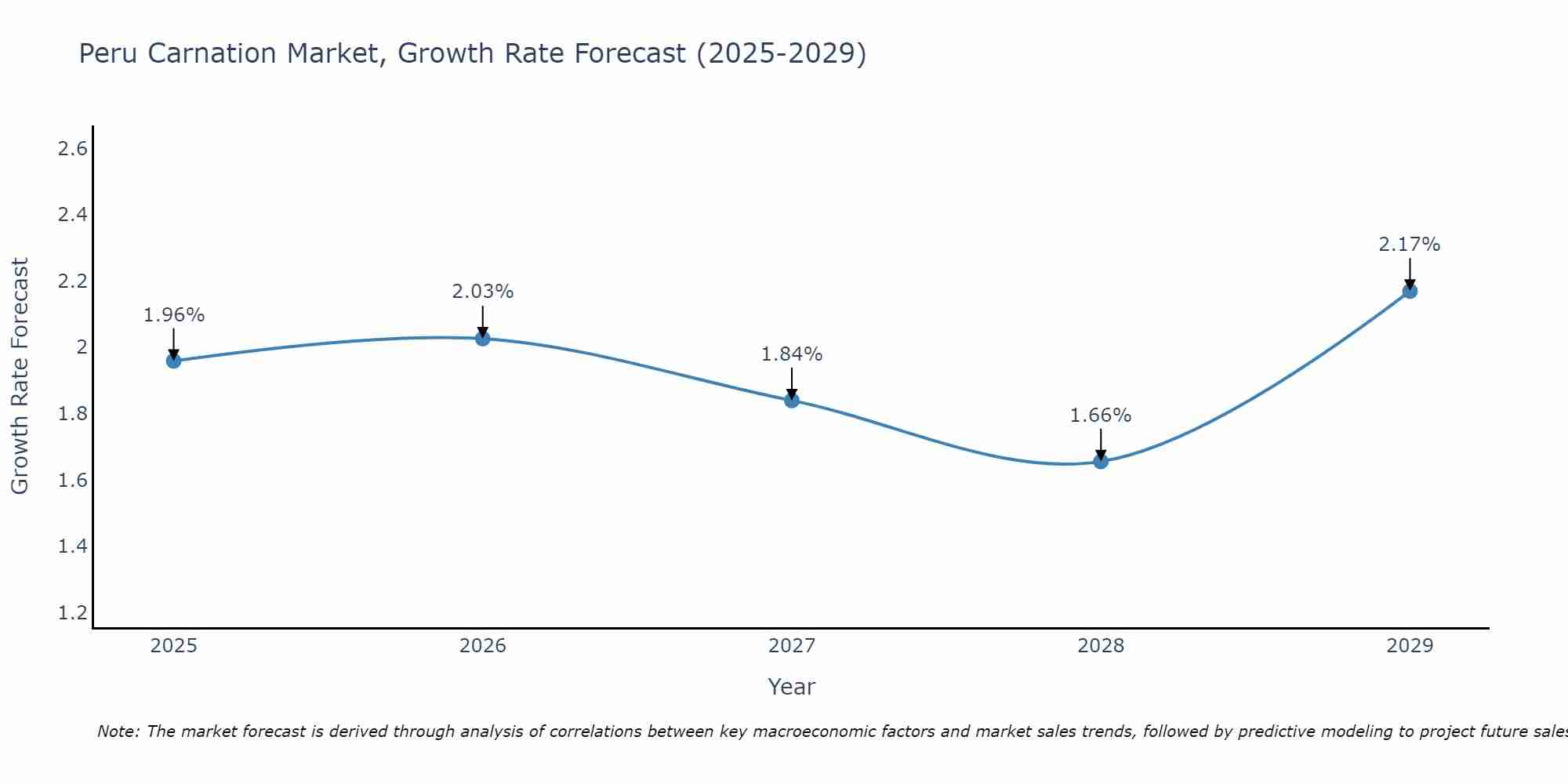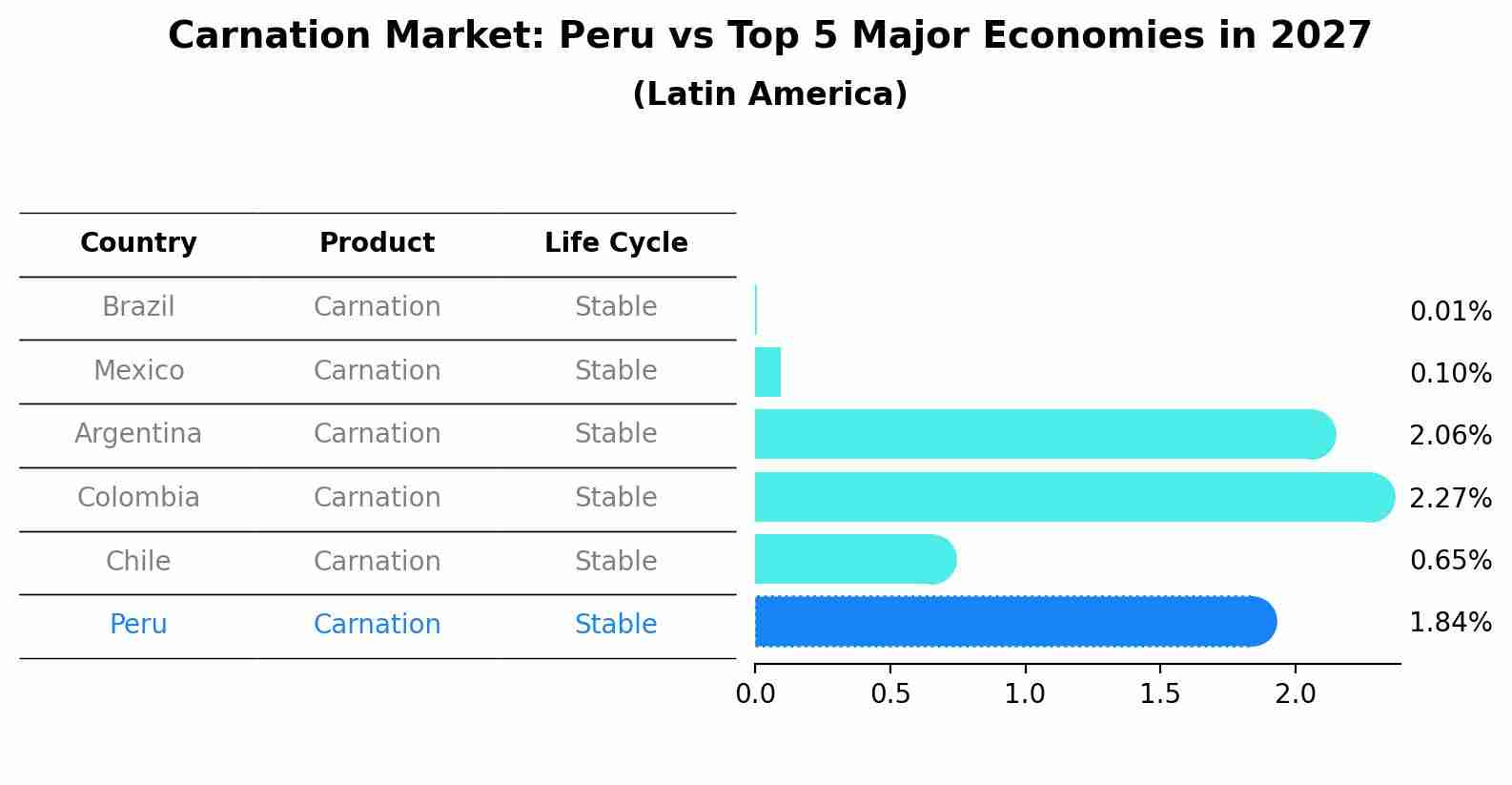Peru Carnation Market (2025-2031) Outlook | Industry, Companies, Growth, Trends, Forecast, Size, Revenue, Analysis, Share & Value
| Product Code: ETC408962 | Publication Date: Oct 2022 | Updated Date: Jul 2025 | Product Type: Market Research Report | |
| Publisher: 6Wresearch | Author: Vasudha | No. of Pages: 75 | No. of Figures: 35 | No. of Tables: 20 |
Peru Carnation Market Size Growth Rate
The Peru Carnation Market is projected to witness mixed growth rate patterns during 2025 to 2029. Commencing at 1.96% in 2025, growth builds up to 2.17% by 2029.

Carnation Market: Peru vs Top 5 Major Economies in 2027 (Latin America)
By 2027, the Carnation market in Peru is anticipated to reach a growth rate of 1.84%, as part of an increasingly competitive Latin America region, where Brazil remains at the forefront, supported by Mexico, Argentina, Colombia and Chile, driving innovations and market adoption across sectors.

Peru Carnation Market Synopsis
The Peru Carnation Market is a significant segment of the country`s flower industry, with carnations being one of the most popular and widely cultivated flowers in Peru. The market is characterized by a strong domestic demand for carnations due to their use in various cultural and religious celebrations, as well as their popularity in flower arrangements and bouquets. Peru`s favorable climate and rich agricultural traditions have contributed to the high quality of carnations grown in the country, making them sought after in both domestic and international markets. The industry is mostly made up of small to medium-sized flower farms, with a focus on sustainable and environmentally friendly cultivation practices. Export opportunities are also present, with Peru being a key supplier of carnations to markets in the United States, Europe, and other regions.
Peru Carnation Market Trends
The Peru Carnation Market is currently experiencing a trend towards sustainable and eco-friendly practices, with an increasing demand for organic and Fair Trade certified carnations. Consumers are becoming more conscious of the environmental and social impact of their purchases, leading to a shift towards ethically sourced flowers. Additionally, there is a growing preference for unique and exotic carnation varieties, as well as a rising interest in dried and preserved carnation products for long-lasting floral arrangements. The market is also seeing a rise in online sales channels, as e-commerce platforms and social media are becoming popular avenues for purchasing carnations. Overall, the Peru Carnation Market is evolving to meet the changing preferences and values of consumers, with a focus on sustainability, variety, and convenience.
Peru Carnation Market Challenges
In the Peru Carnation Market, one of the key challenges faced is competition from other flower-producing countries such as Colombia and Ecuador, which have established strong footholds in the international market. This intense competition puts pressure on Peruvian carnation producers to differentiate their products in terms of quality, pricing, and variety to remain competitive. Additionally, fluctuations in global demand and prices for carnations can impact the profitability of local producers. Another challenge is the need for sustainable cultivation practices and compliance with international quality and safety standards to meet the requirements of export markets. Inadequate infrastructure and logistics can also present hurdles in timely transportation and delivery of carnations to international markets, affecting the overall competitiveness of the industry.
Peru Carnation Market Investment Opportunities
Investment opportunities in the Peru Carnation Market include vertical integration within the supply chain, such as investing in flower farms to ensure a stable and quality source of carnations. Additionally, there is potential for investments in technology and innovation to improve cultivation techniques, reduce production costs, and increase yields. Export opportunities are also promising, as Peru`s carnation industry has been growing steadily and has a favorable reputation for high-quality flowers in international markets. Collaborating with local farmers and exporters to expand market reach and establish strategic partnerships could further enhance investment prospects in the Peru Carnation Market. Overall, the market presents opportunities for investors looking to capitalize on the country`s growing flower industry and increasing global demand for carnations.
Jordan Agar Market Government Policies
In Peru, government policies related to the carnation market focus on promoting and supporting the growth of the flower industry. Initiatives such as providing subsidies for carnation farmers, implementing quality control measures to ensure the competitiveness of Peruvian carnations in international markets, and offering technical assistance and training programs to improve cultivation practices are part of the government`s strategy. Additionally, efforts to expand market access through trade agreements and partnerships with other countries are being pursued to boost exports of Peruvian carnations. Overall, the government is committed to fostering a sustainable and thriving carnation market in Peru through a combination of financial support, regulatory measures, and market development initiatives.
Peru Carnation Market Future Outlook
The future outlook for the Peru Carnation Market appears positive with steady growth anticipated in the coming years. Factors such as increasing demand for carnations in both domestic and international markets, favorable climatic conditions for cultivation in Peru, and the country`s reputation for high-quality flowers are expected to drive market expansion. Additionally, advancements in technology and techniques for flower cultivation, along with a growing trend towards sustainable and eco-friendly practices, are likely to further boost the market. With the potential for increased exports and a focus on product innovation and marketing strategies, the Peru Carnation Market is poised for continued growth and opportunities for stakeholders in the industry.
Key Highlights of the Report:
- Peru Carnation Market Outlook
- Market Size of Peru Carnation Market, 2024
- Forecast of Peru Carnation Market, 2031
- Historical Data and Forecast of Peru Carnation Revenues & Volume for the Period 2021 - 2031
- Peru Carnation Market Trend Evolution
- Peru Carnation Market Drivers and Challenges
- Peru Carnation Price Trends
- Peru Carnation Porter's Five Forces
- Peru Carnation Industry Life Cycle
- Historical Data and Forecast of Peru Carnation Market Revenues & Volume By Products Type for the Period 2021 - 2031
- Historical Data and Forecast of Peru Carnation Market Revenues & Volume By Standard Carnation for the Period 2021 - 2031
- Historical Data and Forecast of Peru Carnation Market Revenues & Volume By Miniature Carnation for the Period 2021 - 2031
- Historical Data and Forecast of Peru Carnation Market Revenues & Volume By Application for the Period 2021 - 2031
- Historical Data and Forecast of Peru Carnation Market Revenues & Volume By Domestic Field for the Period 2021 - 2031
- Historical Data and Forecast of Peru Carnation Market Revenues & Volume By Business Field for the Period 2021 - 2031
- Peru Carnation Import Export Trade Statistics
- Market Opportunity Assessment By Products Type
- Market Opportunity Assessment By Application
- Peru Carnation Top Companies Market Share
- Peru Carnation Competitive Benchmarking By Technical and Operational Parameters
- Peru Carnation Company Profiles
- Peru Carnation Key Strategic Recommendations
Frequently Asked Questions About the Market Study (FAQs):
- Single User License$ 1,995
- Department License$ 2,400
- Site License$ 3,120
- Global License$ 3,795
Search
Thought Leadership and Analyst Meet
Our Clients
Related Reports
- Germany Breakfast Food Market (2026-2032) | Industry, Share, Growth, Size, Companies, Value, Analysis, Revenue, Trends, Forecast & Outlook
- Australia Briquette Market (2025-2031) | Growth, Size, Revenue, Forecast, Analysis, Trends, Value, Share, Industry & Companies
- Vietnam System Integrator Market (2025-2031) | Size, Companies, Analysis, Industry, Value, Forecast, Growth, Trends, Revenue & Share
- ASEAN and Thailand Brain Health Supplements Market (2025-2031) | Strategy, Consumer Insights, Analysis, Investment Trends, Opportunities, Growth, Size, Share, Industry, Revenue, Segments, Value, Segmentation, Supply, Forecast, Restraints, Outlook, Competition, Drivers, Trends, Demand, Pricing Analysis, Competitive, Strategic Insights, Companies, Challenges
- ASEAN Bearings Market (2025-2031) | Strategy, Consumer Insights, Analysis, Investment Trends, Opportunities, Growth, Size, Share, Industry, Revenue, Segments, Value, Segmentation, Supply, Forecast, Restraints, Outlook, Competition, Drivers, Trends, Demand, Pricing Analysis, Competitive, Strategic Insights, Companies, Challenges
- Europe Flooring Market (2025-2031) | Outlook, Share, Industry, Trends, Forecast, Companies, Revenue, Size, Analysis, Growth & Value
- Saudi Arabia Manlift Market (2025-2031) | Outlook, Size, Growth, Trends, Companies, Industry, Revenue, Value, Share, Forecast & Analysis
- Uganda Excavator, Crane, and Wheel Loaders Market (2025-2031) | Strategy, Consumer Insights, Analysis, Investment Trends, Opportunities, Growth, Size, Share, Industry, Revenue, Segments, Value, Segmentation, Supply, Forecast, Restraints, Outlook, Competition, Drivers, Trends, Demand, Pricing Analysis, Competitive, Strategic Insights, Companies, Challenges
- Rwanda Excavator, Crane, and Wheel Loaders Market (2025-2031) | Strategy, Consumer Insights, Analysis, Investment Trends, Opportunities, Growth, Size, Share, Industry, Revenue, Segments, Value, Segmentation, Supply, Forecast, Restraints, Outlook, Competition, Drivers, Trends, Demand, Pricing Analysis, Competitive, Strategic Insights, Companies, Challenges
- Kenya Excavator, Crane, and Wheel Loaders Market (2025-2031) | Strategy, Consumer Insights, Analysis, Investment Trends, Opportunities, Growth, Size, Share, Industry, Revenue, Segments, Value, Segmentation, Supply, Forecast, Restraints, Outlook, Competition, Drivers, Trends, Demand, Pricing Analysis, Competitive, Strategic Insights, Companies, Challenges
Industry Events and Analyst Meet
Whitepaper
- Middle East & Africa Commercial Security Market Click here to view more.
- Middle East & Africa Fire Safety Systems & Equipment Market Click here to view more.
- GCC Drone Market Click here to view more.
- Middle East Lighting Fixture Market Click here to view more.
- GCC Physical & Perimeter Security Market Click here to view more.
6WResearch In News
- Doha a strategic location for EV manufacturing hub: IPA Qatar
- Demand for luxury TVs surging in the GCC, says Samsung
- Empowering Growth: The Thriving Journey of Bangladesh’s Cable Industry
- Demand for luxury TVs surging in the GCC, says Samsung
- Video call with a traditional healer? Once unthinkable, it’s now common in South Africa
- Intelligent Buildings To Smooth GCC’s Path To Net Zero


















